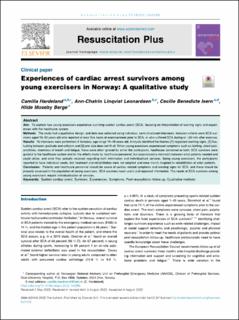| dc.contributor.author | Hardeland, Camilla | |
| dc.contributor.author | Leonardsen, Ann-Chatrin Linqvist | |
| dc.contributor.author | Isern, Cecilie Benedicte | |
| dc.contributor.author | Berge, Hilde Moseby | |
| dc.date.accessioned | 2022-11-29T17:03:08Z | |
| dc.date.available | 2022-11-29T17:03:08Z | |
| dc.date.created | 2022-08-07T19:18:07Z | |
| dc.date.issued | 2022 | |
| dc.identifier.citation | Resuscitation Plus. 2022, 11, Artikkel 100293. | en_US |
| dc.identifier.issn | 2666-5204 | |
| dc.identifier.uri | https://hdl.handle.net/11250/3034841 | |
| dc.description | This is an open access article under the CC BY license (http://creativecommons.org/licenses/by/4.0/). | en_US |
| dc.description.abstract | Aim: To explore how young exercisers experience surviving sudden cardiac arrest (SCA), focusing on interpretation of warning signs and experiences with the healthcare system.
Methods: The study had a qualitative design, and data was collected using individual, semi-structured interviews. Inclusion criteria were SCA survivors aged 18–50 years old who reported at least five hours of exercise/week prior to SCA, or who suffered SCA during or ≤60 min after exercise.
Results: 18 interviews were performed (4 females), age range 19–49 years old. Analysis identified the themes [1] neglected warning signs, [2] fluctuating between gratitude and criticism and [3] one size does not fit all. When young exercisers experienced symptoms such as fainting, chest pain, arrythmia, shortness of breath and fatigue, these were often ignored by either the participants, healthcare personnel or both. SCA survivors were grateful to the healthcare system and for the efforts made by healthcare personnel, but experienced a mismatch between what patients needed and could utilize, and what they actually received regarding both information and individualised services. Being young exercisers, the participants reported to have individual needs, but treatment and rehabilitation were not adapted and were mainly targeted to rehabilitation of older patients.
Conclusion: Patients and healthcare personnel should be aware of cardiac related symptoms and warning signs for SCA, and these should be properly assessed in the population of young exercisers. SCA survivors need useful and repeated information. The needs of SCA survivors among young exercisers require individualisation of services. | en_US |
| dc.language.iso | eng | en_US |
| dc.subject | experiences | en_US |
| dc.subject | post-resuscitation follow-up | en_US |
| dc.subject | qualitative methods | en_US |
| dc.subject | sudden cardiac arrest | en_US |
| dc.subject | survivors | en_US |
| dc.subject | symptoms | en_US |
| dc.title | Experiences of cardiac arrest survivors among young exercisers in Norway: A qualitative study | en_US |
| dc.type | Peer reviewed | en_US |
| dc.type | Journal article | en_US |
| dc.description.version | publishedVersion | en_US |
| dc.rights.holder | © 2022 The Authors | en_US |
| dc.source.pagenumber | 5 | en_US |
| dc.source.volume | 11 | en_US |
| dc.source.journal | Resuscitation Plus | en_US |
| dc.identifier.doi | 10.1016/j.resplu.2022.100293 | |
| dc.identifier.cristin | 2041522 | |
| dc.description.localcode | Institutt for idrettsmedisinske fag / Department of Sports Medicine | en_US |
| dc.source.articlenumber | 100293 | en_US |
| cristin.ispublished | true | |
| cristin.fulltext | original | |
| cristin.qualitycode | 1 | |
